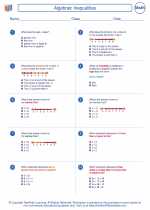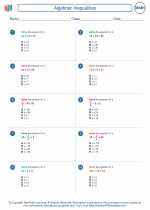Linear Function
A linear function is a type of function in mathematics that can be represented by a straight line when graphed on a coordinate plane. The general form of a linear function is given by the equation y = mx + b, where "m" is the slope of the line and "b" is the y-intercept. The slope represents the rate of change of the function, and the y-intercept is the point where the line crosses the y-axis.
Key Concepts:
- Slope: The slope of a linear function is the ratio of the vertical change (rise) to the horizontal change (run) between any two points on the line.
- Y-Intercept: The y-intercept of a linear function is the value of y when x = 0, and it is the point where the line crosses the y-axis.
- Graphing Linear Functions: Plotting points and using the slope and y-intercept to draw the line on a coordinate plane.
- Equation of a Line: The equation y = mx + b is the standard form of a linear function, where "m" is the slope and "b" is the y-intercept.
- Rate of Change: The slope of a linear function represents the rate at which the dependent variable (y) changes with respect to the independent variable (x).
Study Guide:
- Understand the concept of slope and how it relates to the steepness of a line.
- Practice finding the y-intercept of a linear function and understand its significance in graphing.
- Learn to graph linear functions by plotting points and using the slope and y-intercept.
- Practice converting linear equations between standard form and slope-intercept form (y = mx + b).
- Understand how to interpret the slope as a rate of change in real-world scenarios.
Understanding linear functions is crucial in algebra and lays the groundwork for more advanced topics in mathematics such as systems of linear equations, slope-intercept form, and linear inequalities.
Good luck with your studies!
.◂Math Worksheets and Study Guides Seventh Grade. Algebraic Inequalities
Study Guide Algebraic Inequalities
Algebraic Inequalities  Worksheet/Answer key
Worksheet/Answer key Algebraic Inequalities
Algebraic Inequalities  Worksheet/Answer key
Worksheet/Answer key Algebraic Inequalities
Algebraic Inequalities  Worksheet/Answer key
Worksheet/Answer key Algebraic Inequalities
Algebraic Inequalities 

 Worksheet/Answer key
Worksheet/Answer key
 Worksheet/Answer key
Worksheet/Answer key
 Worksheet/Answer key
Worksheet/Answer key

The resources above cover the following skills:
Algebra (NCTM)
Represent and analyze mathematical situations and structures using algebraic symbols.
Use symbolic algebra to represent situations and to solve problems, especially those that involve linear relationships.